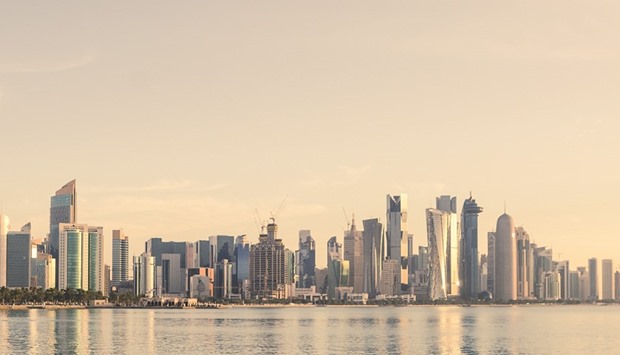Qatar’s fiscal balance as a percentage of GDP is set to rise to 3.2% in 2024 from an estimated -6.9% this year, FocusEconomics has said in its country report.
The country’s merchandise trade balance may scale up to $50.6bn from $24.4bn this year, it said.
According to FocusEconomics, Qatar’s public debt (as a percentage of GDP) has been forecast to fall to 61.8 from 65.6 this year.
The country’s public debt as a percentage of the gross domestic product will fall continuously over the next four years, the researcher said.
It is projected at 67.6 next year, 66 (in 2022) and 63.9 in 2023.
Qatar’s GDP has been estimated to reach $220bn in 2024 from $180bn this year.
Next year, it will be $189bn, followed by $199bn (2022) and $209bn in 2023.
GDP per capita, FocusEconomics said, has been estimated to reach $79,072 in 2024 from $65,395 this year.
GDP per capita next year will be $68,249, followed by $71,585 in 2022 and $75,185 in 2023.
Qatar’s economic growth in terms of nominal GDP will reach 5.4% in 2024 from -1.6% by the year-end.
Next year, economic growth in terms of nominal GDP will be 4.6%, 5.2% in 2022 and 5.3% in 2023.
The current account balance (as a percentage of GDP) will be 3.1 in 2024 compared with -4.4 in 2020, -0.6 (2021), 1.9 (2022) and 2.5 in 2023.
International reserves may exceed $34.9bn in 2024, from $35.3bn this year.
The country’s inflation, the report noted, will be 0% this year, 1.5% (2021), 1.8% (2022), 1.8% (2023) and 1.9% in 2024.
Qatar’s unemployment rate (as a percentage of active population) will remain a meagre 0.2% in 2024, unchanged from this year.
According to FocusEconomics, Qatar government’s “fiscal package of roughly 13% of GDP should be cushioning the blow to activity and help spark a rebound once the pandemic subsides.”
The economy will have likely contracted notably in the first quarter, after shrinking in the second half of last year due to a “sharp deterioration” in the energy sector.
Covid-19 containment measures and travel restrictions “battered” domestic demand in Q1, particularly the tourism and retail sectors, while a sharp fall in hydrocarbon prices weighed heavily on merchandise exports.
FocusEconomics said, “Economic prospects for this year soured considerably as the lockdown will likely hammer the tourism and retail sectors for the majority of the year. Moreover, depressed oil and gas prices will weigh on government finances and the external sector.
“Nevertheless, strong fiscal stimulus and spending on infrastructure projects should prop up activity. FocusEconomics panelists see a 1.6% contraction in GDP in 2020, which is down 1.8 percentage points from last month’s forecast, before a growth of 3.1% in 2021.”
According to FocusEconomics, Qatar’s public debt (as a percentage of GDP) has been forecast to fall to 61.8 from 65.6 this year.
The country’s public debt as a percentage of the gross domestic product will fall continuously over the next four years, the researcher said.
It is projected at 67.6 next year, 66 (in 2022) and 63.9 in 2023.
Qatar’s GDP has been estimated to reach $220bn in 2024 from $180bn this year.
Next year, it will be $189bn, followed by $199bn (2022) and $209bn in 2023.
GDP per capita, FocusEconomics said, has been estimated to reach $79,072 in 2024 from $65,395 this year.
GDP per capita next year will be $68,249, followed by $71,585 in 2022 and $75,185 in 2023.
Qatar’s economic growth in terms of nominal GDP will reach 5.4% in 2024 from -1.6% by the year-end.
Next year, economic growth in terms of nominal GDP will be 4.6%, 5.2% in 2022 and 5.3% in 2023.
The current account balance (as a percentage of GDP) will be 3.1 in 2024 compared with -4.4 in 2020, -0.6 (2021), 1.9 (2022) and 2.5 in 2023.
International reserves may exceed $34.9bn in 2024, from $35.3bn this year.
The country’s inflation, the report noted, will be 0% this year, 1.5% (2021), 1.8% (2022), 1.8% (2023) and 1.9% in 2024.
Qatar’s unemployment rate (as a percentage of active population) will remain a meagre 0.2% in 2024, unchanged from this year.
According to FocusEconomics, Qatar government’s “fiscal package of roughly 13% of GDP should be cushioning the blow to activity and help spark a rebound once the pandemic subsides.”
The economy will have likely contracted notably in the first quarter, after shrinking in the second half of last year due to a “sharp deterioration” in the energy sector.
Covid-19 containment measures and travel restrictions “battered” domestic demand in Q1, particularly the tourism and retail sectors, while a sharp fall in hydrocarbon prices weighed heavily on merchandise exports.
FocusEconomics said, “Economic prospects for this year soured considerably as the lockdown will likely hammer the tourism and retail sectors for the majority of the year. Moreover, depressed oil and gas prices will weigh on government finances and the external sector.
“Nevertheless, strong fiscal stimulus and spending on infrastructure projects should prop up activity. FocusEconomics panelists see a 1.6% contraction in GDP in 2020, which is down 1.8 percentage points from last month’s forecast, before a growth of 3.1% in 2021.”




